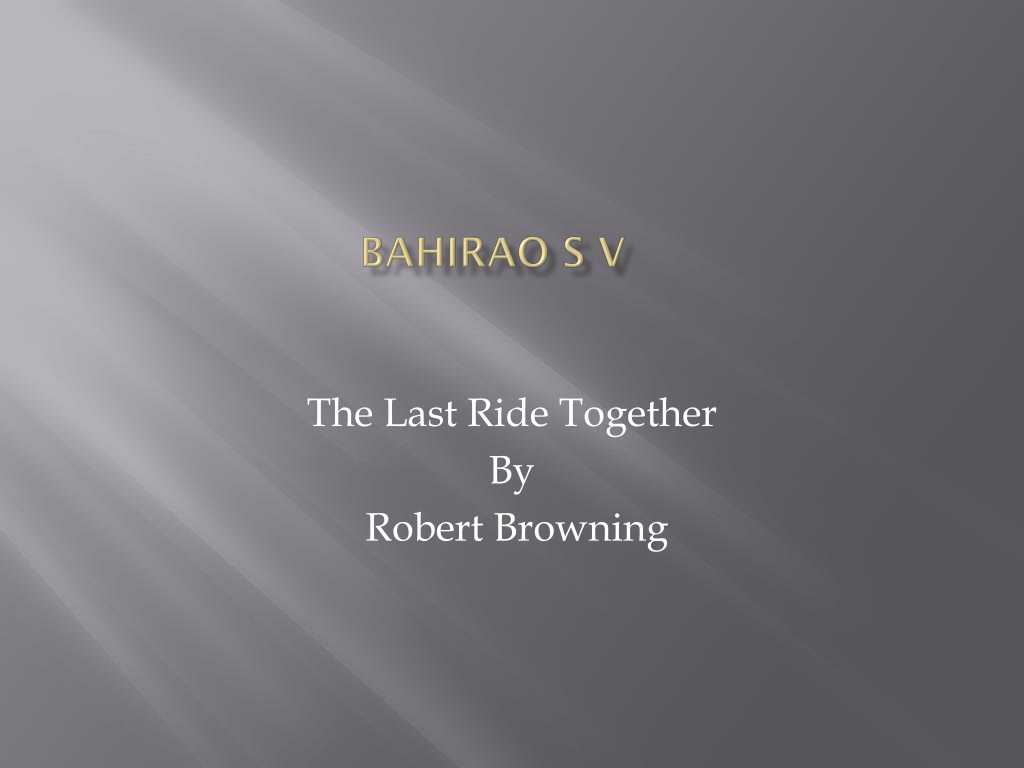
Exploring Robert Browning's Poem 'The Last Ride Together'
Delve into Robert Browning's dramatic monologue, "The Last Ride Together," published in 1855. This philosophical poem reflects on love, life, success, and failure with robust optimism. Follow the narrator's poignant journey as he confronts fate, expresses love for his companion, and embarks on a final ride together, embracing the passing nature of life.
Download Presentation

Please find below an Image/Link to download the presentation.
The content on the website is provided AS IS for your information and personal use only. It may not be sold, licensed, or shared on other websites without obtaining consent from the author. Download presentation by click this link. If you encounter any issues during the download, it is possible that the publisher has removed the file from their server.
E N D
Presentation Transcript
The Last Ride Together By Robert Browning
About the Poet: Robert Browning (7 th May 1812- 12th Dec. 1889) is an English poet and playwright whose Mastery of the dramatic monologue made him one of the foremost victorian poets.
Notable Works: 1) Men and Women 2) The Ring and the Book 3) Pied Piper of Hamelin 4) Dramatic Lyrics 5) Dramatic Romance and Lyrics 6) Dramtis Personae
About the Poem: It was published in 1855. The Last Ride Together is a dramatic monologue. It is a philosophical revelation on love, life, success and failure. It is a poem of robust optimism.
In the first stanza, the narrator blames the end of his romance on fate. He bemoans that everything he has tried has failed, and it seems the end of his love affair is set. Despite this, he expresses his love and appreciation for the woman he has spent years with, and blesses her name. He asks only for her the memory of the time they shared together, and one last ride with her before she goes.
The second stanza focuses on the womans reaction, as she surveys him with pride tempered with pity. The narrator compares waiting for her answer with life or death, accentuating the emotional stakes that are always at play when it comes to love and passion. In the end, they say yes, and the parting couple embarks on their final ride together.
The third stanza focuses on the blissful feeling of that last ride, with the narrator waxing poetic about how wonderful the time together feels. He focuses on the beauty of the surroundings, the passion he feels, and the ecstatic feeling that he feels when she touches him. She has provided him with more than he asked for, and he is filled with gratitude for this.
The fourth stanza focuses on Brownings philosophy of the passing nature of life. The narrator begins to let go of what was and begins to enjoy what is. He describes his soul as smoothing out as he lets go of past hopes. He knows that there s no point to speculating what could have been. Things could be better or worse, and instead he chooses to simply enjoy the moment that they are sharing together.
The fifth stanza continues the themes in the fourth, with the narrator contrasting himself with men who strove for other things, and those who have failed. He does this to hide his personal anguish over the end of his affair. He accepts his defeat and expresses his hope for a better future in heaven at the end of his life.
The sixth stanza presents the philosophical idea that a life of contemplation in love is far better than any pleasures that the material world can provide. This stanza contains many allusions and analogies, such as comparing the greatest joys of life to a crown that one can reach. It compares the life of a love with that of a statesman and a soldier, and comes down firmly on the idea that the lover s life is superior.
The seventh and eighth stanzas focus on comparisons of the love to a great poet and later a great sculptor. The narrator describes the talents of these artists the poet s work being defined by how they create rhyme and rhythm, while the sculptor devotes years to a chunk of rock and carves something spectacular out of it. He later does the same with a composer, stringing notes together. He compares these arts to the years of his life he gave to his love, attempting to create something beautiful out of their union.
In the ninth stanza, the narrator wonders what fate has in store for them, and admits he has no idea what would have transpired had they remained together. He expresses his regret that it has to end here, but admits that there is nothing he can do and chooses to let go, stating that his life with his lover is now as far away from him as heaven.
The final stanza has him turn his focus back to his lover, as he observes her and notes that she hasn t said anything in a while. He wonders what would happen if they simply rode forever, together, and this instant they shared was made eternity. That is where the poem ends, on that wistful note for an eternity of this moment, without the future apart that awaits them when the ride ends.
